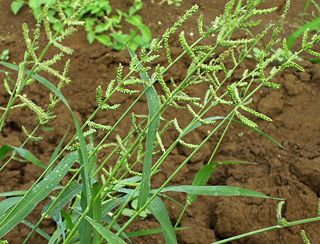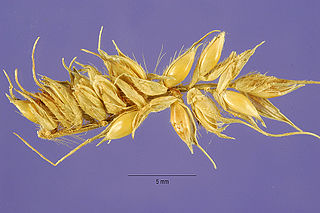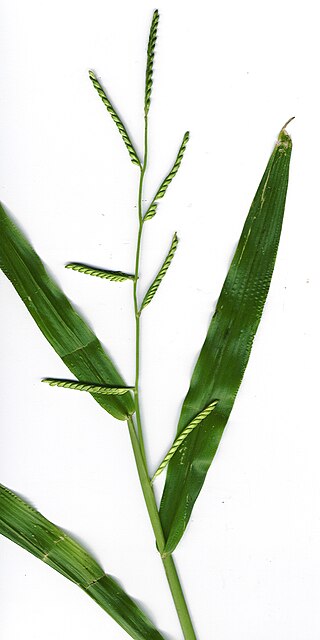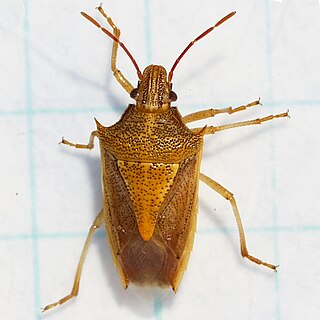
Millets are a highly varied group of small-seeded grasses, widely grown around the world as cereal crops or grains for fodder and human food. Most species generally referred to as millets belong to the tribe Paniceae, but some millets also belong to various other taxa.

Panicum (panicgrass) is a large genus of about 450 species of Poaceae grasses native throughout the tropical regions of the world, with a few species extending into the northern temperate zone. They are often large, annual or perennial grasses, growing to 1–3 m (3–10 ft) tall.

Echinochloa frumentacea is a species of Echinochloa. Both Echinochloa frumentacea and E. esculenta are called Japanese millet. This millet is widely grown as a cereal in India, Pakistan, and Nepal. Its wild ancestor is the tropical grass Echinochloa colona, but the exact date or region of domestication is uncertain. It is cultivated on marginal lands where rice and other crops will not grow well. The grains are cooked in water, like rice, or boiled with milk and sugar. Sometimes it is fermented to make beer. While also being part of staple diet for some communities in India, these seeds are, in particular, eaten during religious fasting. For this reason, these seeds are commonly also referred to as "vrat ke chawal" in Hindi. Other common names to identify these seeds include oodalu (ಊದಲು) in Kannada, Shyamak (শ্যামাক) or Shyama Chal in Bangla, jhangora in the Garhwal Hills, bhagar (भगर) in Marathi-speaking areas, samo or morio seeds in Gujarati, or kuthiraivaali (குதிரைவாளி) in Tamil.

Echinochloa esculenta is a species of grass in the family Poaceae. It is referred to by the common names Japanese barnyard millet or Japanese millet, is a species of Echinochloa that is cultivated on a small scale in India, Japan, China and Korea, both as a food and for animal fodder. It is grown in areas where the land is unsuitable or the climate too cool for paddy rice cultivation. However, the development of rice varieties that can withstand cold has led to a sharp decline in the cultivation of Japanese barnyard millet, in favor of rice. The earliest records of the domesticated form date to 2000 BC from the Jōmon period of Japan.

Echinochloa colonum, commonly known as jungle / wild rice, deccan grass, jharua or awnless barnyard grass, is a type of wild grass originating from tropical Asia. It was formerly classified as a species of Panicum. It is the wild ancestor of the cultivated cereal crop Echinochloa frumentacea, sawa millet. Some taxonomists treat the two taxa as one species, in which case the domesticated forms may also be referred to as E. colonum.

Echinochloa is a very widespread genus of plants in the grass family and tribe Paniceae. Some of the species are known by the common names barnyard grass or cockspur grass.

Echinochloa crus-galli is a type of wild grass originating from tropical Asia that was formerly classified as a type of panicum grass. It is commonly known as cockspur, barnyard millet, Japanese millet, water grass, common barnyard grass, or simply "barnyard grass". This plant can grow to 60" in height and has long, flat leaves which are often purplish at the base. Most stems are upright, but some will spread out over the ground. Stems are flattened at the base. The seed heads are a distinctive feature, often purplish, with large millet-like seeds in crowded spikelets.

Echinochloa stagnina is a species of Echinochloa widespread in tropical Africa and Asia, with an invasive status in many Pacific islands. It was once one of the major grasses cultivated in the Inner Niger Delta of the Niger River. It was cultivated by the Fulani people, who used the seeds as food, and to make both alcoholic and nonalcoholic beverages.
Bipolaris sacchari is a fungal plant pathogen in the family Pleosporaceae.

Echinochloa oryzoides is a species of grass known by the common name early barnyard grass. Its origin is not certain but it may be Eurasia. The grass has been identified as a major weed of rice paddies and has been known to mimic rice.

The angulate tortoise is a species of tortoise found in dry areas and coastal scrub vegetation in South Africa. This tortoise is the only known member of the genus Chersina.

Echinochloa crus-pavonis is a species of grass known by the common name gulf cockspur grass. It is native to much of the Americas, Africa, and part of Asia, and it is known throughout the world as an introduced species. It is an annual grass often exceeding 1.5 meters in maximum height. The inflorescence is divided into several branches coated in green spikelets.
Pseudechinolaena is a genus of tropical and subtropical plants in the grass family, all but one species endemic to Madagascar.

Brachiaria, or signalgrass, is a genus of plants in the grass family native to tropical and subtropical regions of Asia, Africa, Australia, southern Europe, the Americas, and various islands. There are over 100 species.
Galli were priests of the Phrygian goddess Cybele.

Oebalus pugnax, the rice stink bug, is a flying insect in the shield bug family Pentatomidae native to North America that has become a major agricultural pest in the Southern United States. It has been a known pest since at least the time of Johan Christian Fabricius, who described the species in 1775.

Echinochloa pyramidalis is a species of large grass, occurring naturally in flooded regions and beside lakes in tropical Africa and America, and introduced to various other countries. It is commonly known as antelope grass.
Atherigona falcata, the barnyard millet shoot fly, is a species of fly in the family Muscidae. It is found throughout Asia. It is known to affect Echinochloa colona, Echinochloa frumentacea, Echinochloa stagnina, and Panicum sumatrense.

Spodiopogon formosanus or the Taiwan oil millet is a species of perennial grass in the family Poaceae. It is endemic to Taiwan. It is traditionally grown as a cereal crop by the Taiwanese aborigines.














